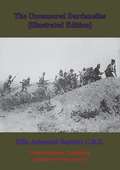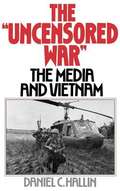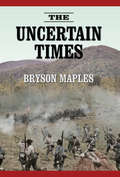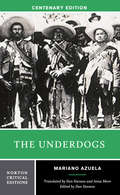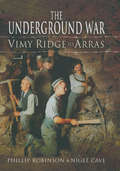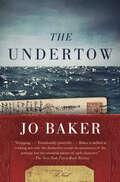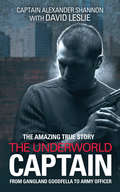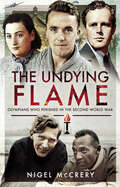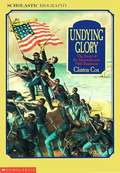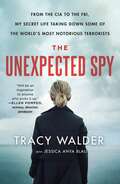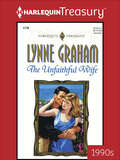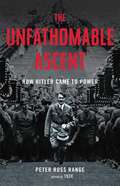- Table View
- List View
The Uncensored Dardanelles [Illustrated Edition]
by Ellis Ashmead-Bartlett C.B.E.The Gallipoli campaign has been written about by many authors. However, few have been as well placed to offer eyewitness testimony of the higher echelons of command as the famed War Correspondent Ellis Ashmead-Bartlett. His dispatches from the field were instrumental in forming the public opinion of the campaign and were at the forefront of creating the enduring Anzac legend.In this volume he recounts the pain and suffering of the troops in the field juxtaposed with bitterly critical vignettes of the commander's errors. He moved in the highest and lowest circles of the expeditionary force, writing of the men as much as the dithering generals at the top. His acerbic dispatches, which were printed at the time, although highly censored, led to his dismissal as correspondent. He lobbied in the highest circles in London to get the troops recalled, in the British government starved sober information from the front listened, and his intervention was pivotal in ending the murderous campaign. After the war, he set his sights on ensuring that the events which he witnessed would be left to posterity without the pen of the censor, giving his account in this book.Author -- Ashmead-Bartlett C.B.E., Ellis, 1881-1931.Text taken, whole and complete, from the edition published in London, Hutchinson & Co. Ltd, 1928Original Page Count - 286 pages.Illustrations - 25 and 2 maps.
The Uncensored War: The Media and Vietnam
by Daniel C. HallinThe 'Uncensored War' provides a deeply detailed account of what Americans read and watched about Vietnam. Hallin draws on the complete body of the New York times coverage from 1961 to 1965, on hundreds of television reports from 1965-73, including television footage filmed by the Defense Department during the early years of the war, and on interviews with many of the journalists who reported the war, to give a powerful critique of the conventional wisdom, both conservative and liberal, about the media and Vietnam.
The Uncertain Times
by Bryson MaplesAs the Civil War ravages the country and his family, Nathaniel Mitchell joins the Confederate cause in Georgia after witnessing a fierce battle in his own backyard. Like most men from Appalachia, he had never seen a slave and didn't think much about slavery, but had joined to protect his family and keep their land from being overrun. Under the command of General Johnston, Nathaniel traverses the trails of the Atlanta Campaign. Plagued by guilt for joining the war without his mother's consent, and ever mindful of the responsibilities he forsook to take on the responsibilities of war, Nathaniel finds a mentor and forges friendships that contribute more than just wisdom to the Mitchell family, and, in the end, given Nathaniel a gift he could never repay.
The Uncharted Flight of Olivia West: A Novel
by Sara AckermanAn exciting page-turner about a fearless female aviator competing in a death-defying race across the Pacific. Brilliantly told… My favorite read this year!&” —Andie Newton, USA TODAY bestselling author of A Child for the ReichThis extraordinary novel, inspired by real events, tells the story of a female aviator who defies the odds to embark on a daring air race across the Pacific.1927. Olivia "Livy" West is a fearless young pilot with a love of adventure. She yearns to cross oceans and travel the skies. When she learns of the Dole Air Race—a high-stakes contest to be the first to make the 2,400 mile Pacific crossing from the West Coast to Hawai'i—she sets her sights on qualifying. But it soon becomes clear that only men will make the cut. In a last-ditch effort to take part, Livy manages to be picked as a navigator for one of the pilots, before setting out on a harrowing journey that some will not survive.1987. Wren Summers is down to her last dime when she learns she has inherited a remote piece of land on the Big Island with nothing on it but a dilapidated barn and an overgrown mac nut grove. She plans on selling it and using the money to live on, but she is drawn in by the mysterious objects kept in the barn by her late great-uncle—clues to a tragic piece of aviation history lost to time. Determined to find out what really happened all those years ago, Wren enlists the help of residents at a nearby retirement home to uncover Olivia&’s story piece by piece. What she discovers is more earth-shattering, and closer to home, than she could have ever imagined.Don't miss THE GUEST IN ROOM 120, Sara Ackerman's enthralling new novel with dual-timelines intertwining a 1905 mystery surrounding Jane Stanford's mysterious death in Honolulu and a 2005 writer's quest to uncover the truth at the same historic hotel...More captivating stories from Sara Ackerman: The Maui Effect The Codebreaker's Secret Radar Girls Red Sky Over Hawaii The Lietenant's Nurse Island of Sweet Pies & Soldiers
The Undercover Affair
by Cathryn ParryTo choose between justice and love There's a burglar on the loose in the beach town of Wallis Point, and undercover detective Lyndsay Fairfax is pursuing every lead. Even the one that takes her straight to the brother of handsome marine veteran John Reilly. John, whose lively restaurant is the heart of the town, is the first person Lyndsay has connected with since her husband's death. But she can't tell him who she really is, and she can't let his brother slide if he's the culprit. Lyndsay has to figure out how to do the right thing without also losing the man who is so right for her...
The Undercover Billionaire: A Billionaire SEAL Romance (The Tate Brothers #3)
by Jackie AshendenThe Tate Brothers were raised to protect what is theirs…Navy SEAL Wolf Tate is on a mission of vengeance. He’s willing to do whatever it takes to infiltrate the lair of his arms-dealing enemy—and rescue the mother he never knew. To do this, he’ll need more than his father’s fortunes or his brothers-in-arms.He must find a way to kidnap his enemy’s daughter for leverage. There’s just one problem: She is also one of Wolf’s closest friends—and the only woman he’s ever loved…For years, Olivia de Santis has been waiting for Wolf to take her in his arms and make her dreams come true. But she never imagined that he’d sneak into her bedroom one night…and take her as his hostage. Olivia knows she should resist him—and stay loyal to her own family. But how can she deny the burning justice of Wolf’s mission, and the blazing desire in his eyes—even if giving into the heat of the moment can put her in grave danger? Jackie Ashenden’s novels are:“Sexy, emotional.” —Laurelin Paige, New YorkTimes bestselling author“Tantalizing . . . explosive.”—Publishers Weekly (starred review) on Mine to Take
The Undercover Nazi Hunter: Exposing Subterfuge and Unmasking Evil in Post-War Germany
by Wolfe FrankWolfe Frank was Chief Interpreter at the Nuremberg Trials where he was dubbed &‘The Voice of Doom.&’ A playboy turned resistance worker he had fled Germany for England in 1937 having been branded an &‘enemy of the state – to be shot on sight.&’ Initially interned as an &‘enemy alien,&’ he was later released and allowed to join the British Army – where he rose to the rank of Captain. Unable to speak English when he arrived by the time of the trials he was considered to be the finest interpreter in the world. In the months following his service at Nuremberg, Frank became increasingly alarmed at the misinformation coming out of Germany so in 1949, backed by the New York Herald Tribune, he risked his life again by returning to the country of his birth to make an &‘undercover&’ survey of the main facets of postwar German life and viewpoints. During his enterprise he worked as a German alongside Germans in factories, on the docks, in a refugee camp and elsewhere. Equipped with false papers he sought objective answers to many questions including: refugees, anti-Semitism, morality, de-Nazification, religion, and nationalism. The NYHT said at the time: &‘A fresh appraisal of the German question could only be obtained by a German and Mr Frank had all the exceptional qualifications necessary. We believe the result of his &“undercover" work told in human, factual terms, is an important contribution to one of the great key problems of the postwar world … and incidentally it contains some unexpected revelations and dramatic surprises.&’ The greatest of those surprises was Frank single-handedly tracking down and arresting the SS General ranked &‘fourth&’ on the allies &‘most wanted&’ list – and personally taking and transcribing the Nazi&’s confession. The Undercover Nazi Hunter not only reproduces Frank&’s series of articles (as he wrote them) and a translation of the confession, which, until now, has never been seen in the public domain, it also reveals the fascinating behind-the-scenes story of a great American newspaper agonizing over how best to deal with this unique opportunity and these important exposés.
The Underdogs
by Mariano AzuelaLos de abajo (The Underdogs) is Mariano Azuela's unforgettable novel of the Mexican Revolution (1910-17). It is widely regarded as the best Mexican novel about the war and was published during the armed struggle. This Norton Critical Edition is based on a new translation by acclaimed scholars Ilan Stavans and Anna More. It is accompanied by Stavans' introduction and explanatory footnotes. Numerous artists and intellectuals have commented on The Underdogs, and the Norton Critical Edition includes a judicious selection of these comments to help place the novel in its historical context. The eyewitness account of John Reed is joined by the assessments of Anita Brenner and Octavio Paz. A 1994 letter by Subcomandante Marcos to Mexico's then-president Ernesto Zedillo points to the Mexican Revolution as an unfinished event, one that brought little relief to large segments of the country's population. Five wide-ranging critical assessments of Mariano Azuela and The Underdogs are provided by Waldo Frank, Harriet de On#65533;s, Luis Leal, Ilan Stavans, and Clive Griffin. A selected bibliography is also included.
The Underdogs: A Novel Of The Mexican Revolution (Dover Thrift Editions)
by Mariano AzuelaRenowned as the greatest novel of the Mexican Revolution, The Underdogs recounts a young peasant's recruitment into Pancho Villa's army. Demetrio Macías is compelled to defend his home from attacks by the Federales who serve Mexico's hated dictator. Forced into a fugitive existence, he encounters a rebel band and becomes their charismatic leader, shaping the vagabonds into a dynamic guerrilla force. The unit is further strengthened by an unlikely ally, the aristocratic intellectual Luis Cervantes, whose revulsion at the country's rampant social injustice has turned him against the government. But the escalating violence and harsh realities of war erode Demetrio's and Cervantes' idealism, undermining their alliance and leading to their ultimate disillusionment. Mexican author and physician Mariano Azuela González (1873–1952) drew upon his experiences as a medic with Villa's troops to create this iconic work of Latin American literature. Prized for its authentic representation of Mexican peasant life, the novel offers a timeless portrayal of revolutionary zeal and disenchantment.
The Underdogs: A Novel of the Mexican Revolution
by Mariano Azuela Carlos Fuentes Sergio WaismanThe greatest novel of the Mexican Revolution, in a brilliant new translation by an award-winning translatorThe Underdogs is the first great novel about the first great revolution of the twentieth century. Demetrio Macias, a poor, illiterate Indian, must join the rebels to save his family. Courageous and charismatic, he earns a generalship in Pancho Villa?s army, only to become discouraged with the cause after it becomes hopelessly factionalized. At once a spare, moving depiction of the limits of political idealism, an authentic representation of Mexico?s peasant life, and a timeless portrait of revolution, The Underdogs is an iconic novel of the Latin American experience and a powerful novel about the disillusionment of war.
The Underground Library: A Novel
by Jennifer RyanWhen the Blitz imperils the heart of a London neighborhood, three young women must use their fighting spirit to save the community&’s beloved library in this novel based on true events from the author of The Chilbury Ladies&’ Choir.When the new deputy librarian, Juliet Lansdown, finds that Bethnal Green Library isn&’t the bustling hub she is expecting, she becomes determined to breathe life back into it. But can she show the men in charge that a woman is up to the task of running the library, especially when a confrontation with her past threatens to derail her? Katie Upwood is thrilled to be working at the library, although she is only there until she heads off to university in the fall. But after the death of her beau on the front line and amid tumultuous family strife, she finds herself harboring a life-changing secret with no one to turn to for help. Sofie Baumann, a young Jewish refugee, came to London on a domestic service visa only to find herself working as a maid for a man who treats her abominably. She escapes to the library every chance she can, finding friendship in the literary community and aid in finding her sister, who is still trying to flee occupied Europe. When a slew of bombs destroys the library, Juliet relocates the stacks to the local Underground station where the city&’s residents shelter nightly, determined to lend out stories that will keep spirits up. But tragedy after tragedy threatens to unmoor the women and sever the ties of their community. Will Juliet, Kate, and Sofie be able to overcome their own troubles to save the library? Or will the beating heart of their neighborhood be lost forever?
The Underground War: Vimy Ridge to Arras
by Nigel Cave Philip J. RobinsonThis is the first part of a planned four-volume series focusing on a hitherto largely neglected aspect of the Great War on the Western Front - the war underground. The subject has fascinated visitors to the battlefields from the very beginning of battlefield pilgrimages in the years immediately after the Armistice, and locations such as Hill 60 and the Grange Subway at Vimy have always been popular stops on such tours. Three other volumes will follow, covering the Somme, Ypres and French Flanders. Each book in the series has a short description of the formation and development of Tunnelling Companies in the BEF and a glossary of technical terms.This volume looks mainly at the central Artois, the environs of the whole line of the Vimy Ridge to the River Scarpe and Arras. It does not aim to be a complete treatment of the intensive mining operations along this front. It concentrates on mining, in the area of Vimy Ridge, in Arras itself and at the use of ancient underground quarries, taking Roeux as a good example. There are extensive descriptions of mining on and around Vimy Ridge, including photography and explanations of systems that have been accessed recently but are closed to the public, such as the Goodman Subway. The narrative draws on French and German archival material and personal descriptions. The text is illustrated with numerous diagrams and maps, in particular from the British and German records, and there is an exhaustive guide to the Grange Subway. Other sites open to the public, in particular the Wellington Cave, are also explained and put into context."BBC History - Archaeologists are beginning the most detailed ever study of a Western Front battlefield, an untouched site where 28 British tunnellers lie entombed after dying during brutal underground warfare. For WWI historians, it's the "holy grail"."
The Underpainter
by Jane UrquhartThe Underpainter is a novel of interwoven lives in which the world of art collides with the realm of human emotion. It is the story of Austin Fraser, an American painter now in his later years, who is haunted by memories of those whose lives most deeply touched his own, including a young Canadian soldier and china painter and the beautiful model who becomes Austin's mistress. Spanning decades, the setting moves from upstate New York to the northern shores of two Great Lakes; from France in World War One to New York City in the '20s and '30s. Brilliantly depicting landscape and the geography of the imagination, The Underpainter is Jane Urquhart's most accomplished novel to date.
The Undertow: A novel
by Jo BakerThe American debut of an enthralling new voice: a vivid, indelibly told work of fiction that follows four generations of a family against the backdrop of a tumultuous century--a novel about inheritance, about fate and passion, and about what it means to truly break free of the past.This is the story of the Hastings family--their secrets, their loves and losses, dreams and heartbreaks--captured in a seamless series of individual moments that span the years between the First World War and the present. The novel opens in 1914 as William, a young factory worker, spends one last evening at home before his departure for the navy . . . His son, Billy, grows into a champion cyclist and will ride into the D-Day landings on a military bicycle . . . His son in turn, Will, struggles with a debilitating handicap to become an Oxford professor in the 1960s . . . And finally, young Billie Hastings makes a life for herself as an artist in contemporary London. Just as the names echo down through the family, so too does the legacy of choices made, chances lost, and truths long buried.From the Hardcover edition.
The Underworld Captain: From Gangland Goodfella To Army Officer
by David Leslie Alexander ShannonAlexander Shannon escaped a shady past to enjoy a glittering career in the army, only to end up back in the thick of criminal activity.Shannon's time as a soldier saw him posted to the Falklands, Northern Ireland and war-torn Bosnia. The rigours of army life took their toll and he found himself drawn into a series of ruthless gang wars. He used the skills he'd learned in the forces to hide weapons, work for drugs racketeers and plot a massacre, and he was offered a fortune to work as a Mafia-style contract assassin.He was questioned over brutal killings and accused of a triple murder attempt, yet his dedication and determination to succeed in the army brought him accolades and a series of promotions. In The Underworld Captain, Shannon explains how he managed to combine a successful army career with dangerous gangland dealings for so long and how he finally broke free for good.
The Undoing of Violet Claybourne: A Novel
by Emily Critchley"Artful, gothic-tinged...an immersive, chilling treat for suspense fans." —Publishers WeeklyFor fans of Sarah Penner and The Foundling comes a slow-burn gothic mystery following Gillian, a young girl enthralled by the enigmatic Claybourne sisters, their house at Thornleigh Hall, and the tragedy that binds them together for good.To become a Claybourne girl, she'll have to betray one first.1938. Gillian Larking, lonely and away at boarding school, is used to going unnoticed. But then she meets Violet Claybourne, her vibrant roommate who takes Gilly under her wing. Violet is unlike anyone Gilly has ever met, and she regales Gilly with tales of her grand family estate and her two elegant sisters. Gilly is soon entranced by stories of the Claybournes, so when Violet invites Gilly to meet her family at Thornleigh Hall, she can't believe her luck.But Gilly soon finds that behind the grand façade of Thornleigh Hall, darkness lurks.Dazzled by the crumbling manor and Violet's enigmatic sisters, Gilly settles into the estate. But when a horrible accident strikes on the grounds, she is ensnared in a web of the sisters' making, forced to make a choice that will change the course of her life forever. Because the Claybournes girls know how to keep secrets, even at the cost of one of their own.With ensnaring prose and layers of friendship, privilege, mental health, and more, The Undoing of Violet Claybourne is a poignant book club read with characters you won't soon forget.
The Undying Flame: Olympians Who Perished in the Second World War
by Nigel McCreryOver 60,000,000 people died worldwide during the course of the Second World War and, in contrast to those slaughtered in The Great War, it was civilian populations that bore the brunt. They perished in the Holocaust, in internment camps, in bombed towns and cities and as ‘collateral damage’, in war zones, such as the Eastern Front and in Asia. Among this carnage were hundred of individuals of all nations who had competed in Olympic Games. Imagine the loss of so many of the world’s greatest sportsmen and women of the present era. The author has painstakingly researched the lives, achievements and circumstances of death of almost five hundred athletes of the period. While many were household names at the time, this exceptional work honors these fallen Olympians and reminds us of the futility and wastefulness of war.
The Undying Glory: The Story of the Massachusetts 54th Regiment
by Clinton CoxDescribes the formation of the all-black 54th Massachusetts Regiment and its valiant battle history from 1863 to 1865.
The Unexpected Family Man: A Clean and Uplifting Romance (Heroes of Dunbar Mountain)
by Alexis MorganA substitute family…Or a second chance at forever? Between running his family&’s bar, volunteer firefighting and becoming guardian of his late best friend&’s son, Shay Barnaby barely has time to sleep. Thank goodness for Carli Walsh, the administrator at Luca&’s school. Carli finds herself helping the grieving little boy adjust to his new world—and marveling at how quickly the three of them feel like a family. But after a previous marriage built on lies, Carli needs the real thing. Can Shay prove he's not just looking for a substitute mother to Luca but a love that lasts a lifetime? A Heroes of Dunbar Mountain StoryUSA TODAY Bestselling AuthorFrom Harlequin Heartwarming: Wholesome stories of love, compassion and belonging.Heroes of Dunbar MountainBook 1: The Lawman's PromiseBook 2: To Trust a HeroBook 3: Second Chance DeputyBook 4: The Unexpected Family ManBook 5: The Firefighter Next Door
The Unexpected Spy: From the CIA to the FBI, My Secret Life Taking Down Some of the World's Most Notorious Terrorists
by Jessica Anya Blau Tracy WalderA highly entertaining account of a young woman who went straight from her college sorority to the CIA, where she hunted terrorists and WMDs"A thrilling tale...Walder’s fast-paced and intense narrative opens a window into life in two of America’s major intelligence agencies" —Publishers Weekly (starred review)When Tracy Walder enrolled at the University of Southern California, she never thought that one day she would offer her pink beanbag chair in the Delta Gamma house to a CIA recruiter, or that she’d fly to the Middle East under an alias identity.The Unexpected Spy is the riveting story of Walder's tenure in the CIA and, later, the FBI. In high-security, steel-walled rooms in Virginia, Walder watched al-Qaeda members with drones as President Bush looked over her shoulder and CIA Director George Tenet brought her donuts. She tracked chemical terrorists and searched the world for Weapons of Mass Destruction. She created a chemical terror chart that someone in the White House altered to convey information she did not have or believe, leading to the Iraq invasion. Driven to stop terrorism, Walder debriefed terrorists—men who swore they’d never speak to a woman—until they gave her leads. She followed trails through North Africa, Europe, and the Middle East, shutting down multiple chemical attacks.Then Walder moved to the FBI, where she worked in counterintelligence. In a single year, she helped take down one of the most notorious foreign spies ever caught on American soil. Catching the bad guys wasn’t a problem in the FBI, but rampant sexism was. Walder left the FBI to teach young women, encouraging them to find a place in the FBI, CIA, State Department or the Senate—and thus change the world.
The Unfaithful Wife (Presents Plus Ser. #53)
by Lynne GrahamA young woman is desperate to leave his sham marriage to a wealthy magnate in this classic contemporary romance by a USA Today–bestselling author.Leah’s marriage to powerful Greek businessman Nik Andreakis was an empty sham, and she was determined to get a divorce. But Nik didn’t want one. In the circumstances, Leah found that totally unbelievable. Why would he want to hang on to a wife he’d been blackmailed into marrying!Leah’s lonely wedding night had set the pattern for the past five years, but now she couldn’t sleep for wondering what motivated her husband. Why, all of a sudden, was he making advances to her when he had ignored her for so long?Originally published in 1995.
The Unfathomable Ascent: How Hitler Came to Power
by Peter Ross RangeThe chilling and little-known story of Adolf Hitler's eight-year march to the pinnacle of German politics.On the night of January 30, 1933, Adolf Hitler leaned out of a spotlit window of the Reich chancellery in Berlin, bursting with joy. The moment seemed unbelievable, even to Hitler. After an improbable political journey that came close to faltering on many occasions, his march to power had finally succeeded.While the path of Hitler's rise has been told in books covering larger portions of his life, no previous work has focused solely on his eight-year climb to rule: 1925-1933. Renowned author Peter Ross Range brings this period back to startling life with a narrative history that describes brushes with power, quests for revenge, nonstop electioneering, American-style campaign tactics, and-for Hitler-moments of gloating triumph followed by abject humiliation.Indeed, this is the tale of a high-school dropout's climb from the infamy of a failed coup to the highest office in Europe's largest country. It is a saga of personal growth and lavish living, a melodrama rife with love affairs and even suicide attempts. But it is also the definitive account of Hitler's unrelenting struggle for control over his raucous movement, as he fought off challenges, built and bullied coalitions, quelled internecine feuds and neutralized his enemies-all culminating in the creation of the Third Reich and the western world's descent into darkness. One of the most dramatic and important stories in world history, Hitler's ascent spans Germany's wobbly recovery from World War I through years of growing prosperity and, finally, into crippling depression.
The Unfinished Journey: America Since World War II
by William H. ChafeBrilliantly written by a prize-winning historian, The Unfinished Journey, Eighth Edition, considers both the paradoxes and the possibilities of postwar America. William H. Chafe portrays the significant cultural and political themes that have colored our country's past and present, including issues of race, class, gender, foreign policy, and economic and social reform. He examines such subjects as the Vietnam War, the civil rights movement, the origins and the end of the Cold War, the culture of the 1970s, the rise of the New Right, the events of September 11th and their aftermath, and various presidencies.
The Unfinished Peace after World War I
by Patrick O. CohrsThis is a highly original and revisionist analysis of British and American efforts to forge a stable Euro-Atlantic peace order between 1919 and the rise of Hitler. Patrick Cohrs argues that this order was not founded at Versailles but rather through the first 'real' peace settlements after World War I - the London reparations settlement of 1924 and the Locarno security pact of 1925. Crucially, both fostered Germany's integration into a fledgling transatlantic peace system, thus laying the only realistic foundations for European stability. What proved decisive was that key decision-makers drew lessons from the 'Great War' and Versailles' shortcomings. Yet Cohrs also re-appraises why they could not sustain the new order, master its gravest crisis - the Great Depression - and prevent Nazism's onslaught. Despite this ultimate failure, he concludes that the 'unfinished peace' of the 1920s prefigured the terms on which a more durable peace could be founded after 1945.
